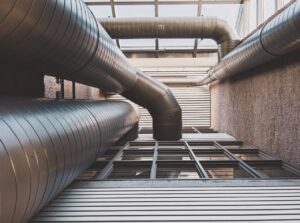Heating and Cooling Systems: A Comprehensive Guide for Homeowners
As homeowners, it is crucial to have an understanding of how our heating and cooling systems operate. It is also important to understand the maintenance they require and when it’s necessary to upgrade our system. However, for most of us, our knowledge is limited to turning on the heat when it’s cold and switching on the air conditioning when it’s hot outside.
Your home’s temperature control system usually comprises three basic components. A source that provides warm or cool air, like an air conditioner or furnace; a way of distributing the air throughout your home, such as vents or ducts; and a method to regulate the temperature, such as a thermostat. The system requires fuel or energy to operate, ranging from electricity to natural gas or propane. The entire system, including the heat pump, air conditioner, furnace, ductwork, filter, air quality products, and more, is referred to as a Heating, Ventilation, and Air Conditioning (HVAC) system.
This comprehensive guide aims to improve your understanding of heating and cooling systems. It includes information on how these systems function, different types of systems available, their maintenance requirements, and signs that indicate the need for a system replacement.
Understanding How HVAC Systems Work
Heating systems use fuel or energy, such as electricity, gas, oil, or wood, to produce heat. This heat is distributed throughout your home via ducts or pipes, depending on the type of system you have. Some systems, such as ductless heat pumps, distribute heated or cooled air directly.
Air conditioners, on the other hand, have two components: an indoor coil and an outdoor condenser. These components work together to absorb heat and humidity from inside your home and move it outside to the outdoor unit. The refrigerant in your cooling system plays a crucial role in this process by transitioning from a gas to a liquid state and cooling warm air as it comes into contact with the coils.
When it comes to ventilation, it encompasses aspects such as air distribution, exhaust, filtering, and energy recovery, among other things.
Ventilation refers to things like air distribution (ductwork), exhaust, filtering, energy recovery, and the like.
Most systems fall into one of these categories:
- Split systems: These are the most common systems – where there is one unit to heat air and another to cool it. The heating system is housed inside (usually in a basement) and the cooling system is placed outside. Hot and cold air is distributed throughout the home by ducts.
- Ductless systems: These systems have individual units that produce both hot and cold air for a specific room or zone. A unit is mounted indoors and is connected to an outdoor compressor.
- Hybrid systems: These systems are set up and function similarly to a split system. The difference is they can switch. between fuel sources (typically gas and electricity) to help maximize efficiency.

Common Heating and Cooling Systems
Forced-air systems: These systems blow heated or cooled air through your home. A forced-air system distributes heat produced by the furnace or the coolness produced by a central air conditioner through an electrically powered fan, called a blower. The blower forces the air through a system of ducts throughout your home. As the warm air from the furnace flows into the rooms, colder air in the rooms flows down through another set of ducts (the cold air return system), to the furnace to be warmed. Central air conditioning systems use the same forced-air system, including the blower, to distribute cool air and bring warmer air back to be cooled.
Heat pumps: A heat pump doesn’t require fuel to produce heat, but instead takes heat out of the air and moves it to another location. They can be used for both heating and cooling and are more energy-efficient than traditional furnaces or air conditioning units. There are two main types: air-source and ground-source. Air-source heat pumps take heat from outdoor air, while ground-source heat pumps use the earth’s constant temperature to provide heating and cooling. Heat pumps are best suited for moderate climates, but in colder climates, a backup heating system may be needed.
Radiant heating: these are another popular option for home heating. Unlike forced-air systems that rely on ductwork, radiant heat systems use pipes or electric heating elements installed beneath the floor, in walls or ceilings to radiate heat into the room. Radiant heating can provide a more even heat distribution compared to forced-air systems, as the heat radiates upward from the floor, heating objects and people in the room rather than just the air. This can also lead to lower energy costs, as the heat stays closer to the ground, where it is needed most. They can be powered by a variety of sources, including electricity, natural gas, or propane. Electric systems are often easier and less expensive to install, but can be more costly to operate in the long run. Gas-powered systems, on the other hand, can be more expensive to install, but tend to be more cost-effective over time.
Summary
Overall, there are many different types of heating and cooling systems available, each with their own benefits and drawbacks. When choosing a system for your home, consider factors such as your climate, budget, energy efficiency goals, and personal preferences. A qualified HVAC professional can help you select the best system for your needs and ensure that it is properly installed and maintained for optimal performance.
By understanding the basics of heating and cooling systems, you can better maintain your system, know when it’s time for a replacement, and take steps to improve its efficiency and effectiveness. Investing in your HVAC system can not only save you money in energy bills and repairs, but also improve the comfort and air quality in your home. So take the time to learn about your system and work with a trusted professional to ensure your system is running at its best.
